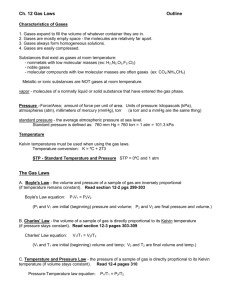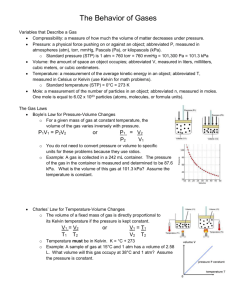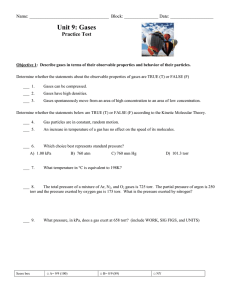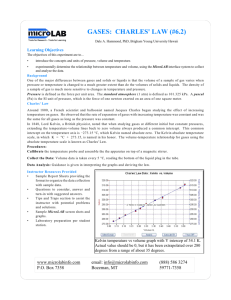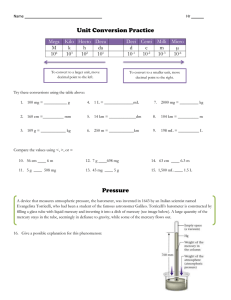Script - Home - Mr. Scramling's Classes and More
advertisement
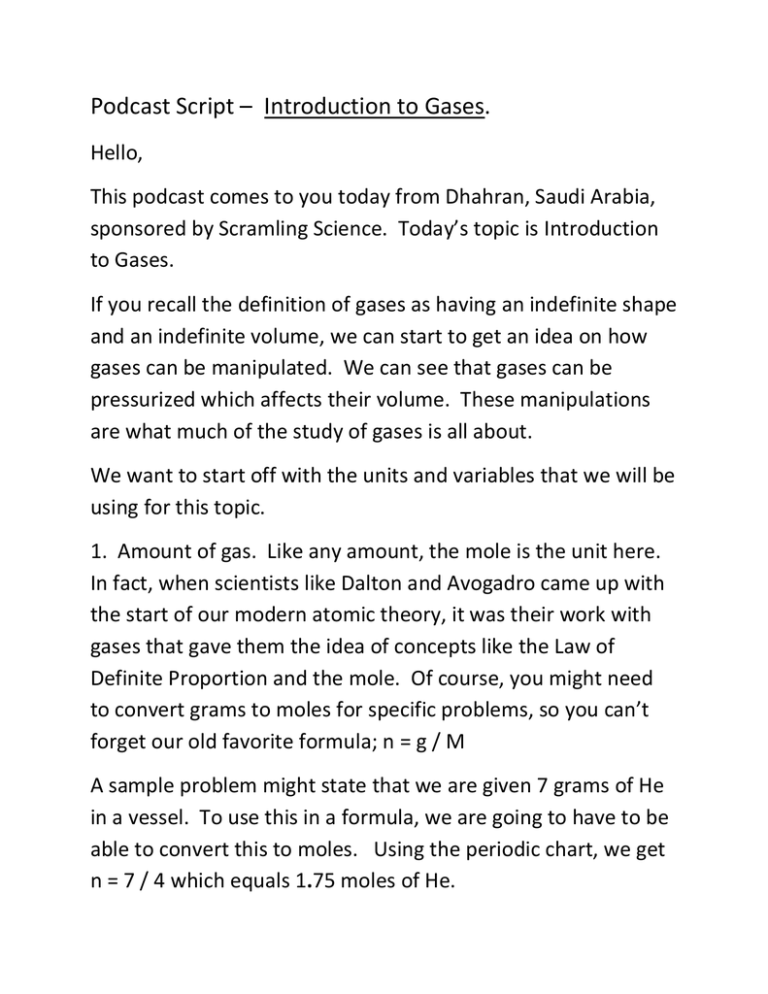
Podcast Script – Introduction to Gases. Hello, This podcast comes to you today from Dhahran, Saudi Arabia, sponsored by Scramling Science. Today’s topic is Introduction to Gases. If you recall the definition of gases as having an indefinite shape and an indefinite volume, we can start to get an idea on how gases can be manipulated. We can see that gases can be pressurized which affects their volume. These manipulations are what much of the study of gases is all about. We want to start off with the units and variables that we will be using for this topic. 1. Amount of gas. Like any amount, the mole is the unit here. In fact, when scientists like Dalton and Avogadro came up with the start of our modern atomic theory, it was their work with gases that gave them the idea of concepts like the Law of Definite Proportion and the mole. Of course, you might need to convert grams to moles for specific problems, so you can’t forget our old favorite formula; n = g / M A sample problem might state that we are given 7 grams of He in a vessel. To use this in a formula, we are going to have to be able to convert this to moles. Using the periodic chart, we get n = 7 / 4 which equals 1.75 moles of He. Make sure that you are using the correct formula especially if you are given the formula in words. It would be a shame if you knew how to do a problem but did it incorrectly because you had Carbon Dioxide as CO instead of CO2 Do you recall your 7 diatomic elements ? They are H2 , N2 , O2 , F2 , Cl2 , Br2 , I2 All of these must be written as a diatomic element as they are not found free in nature in a monatomic state. These are not all that difficult to remember but if you like to use memory devices, there is one for this: HOFBrINCl. 2. Volume. Once again, our units of volume are very familiar to us, the Liter and milliliter. Some formulas require the unit to be Liters, while others only require that the units match up on both sides of the equal sign. 3. Temperature. The unit needed for all gas law formulas is the Kelvin. Recall that K = 273 + °C. In your problems, you will normally be given any temperature in Celsius and it will be up to you to convert to Kelvin. You will not be required to convert any temperatures to or from Fahrenheit. Since the temperature of the gas will affect its properties, there needs to be a standard. This allows us to make comparisons between different gases. The standard temperature is 0 °C, which when converted to Kelvin is 273 Kelvin. Remember when writing out the K for Kelvin, the degree sign of a small circle written as a subscript, is omitted. 4. Pressure. This is the unit when working with gases that presents the most problems with the main reason being for this is that there are several equally acceptable ways to state pressure. In addition, we also have a standard pressure. They will be included when we go over each unit of pressure. The first is atmospheres, symbol of atm. This is said to represent the pressure exerted by the Earth’s atmosphere at sea level. Standard Pressure is 1 atmosphere. The higher the elevation, the lower the pressure becomes because there is less atmosphere above the earth’s surface, the higher you go. Standard Pressure is always 1 atmosphere, no matter where you are situated. The second pressure unit is the mm of Mercury shortened to mmHg or alternatively called the torr, named after Torricelli, an Italian scientist who did early work with gases and their pressures. He invented the barometer. Note that the units of mmHg and Torr are equal and are often interchangeable. You need to know and be aware of both terms. Standard Pressure is 760 torr or 760 mmHg. The third pressure unit is the Pascal or kilopascal, abbreviated Pa or kPa. Depending on the pressure, either unit can be used. As in all SI units, the difference is that the kilopascal is 1,000 times larger than the Pascal. 101.325 kPa is standard pressure. There are other less used units such as pounds per square inch, bar, millibars, etc. Sometimes car tire pressures are measured in pounds per in2. We will often have to convert units from one to another. The key is remembering the standard pressure of each unit: 1 atmosphere = 760 torr = 101.325 kPa Here are a few sample conversion problems. - How many mmHg are in .45 atm. of a gas ? Set up a proportion, remembering that any proportion that we set up will have the set ratio on the left hand side. That means that 760 torr / 1 atm. = x / .45 atm Cross multiplying gives us 342 torr. Earlier we mentioned that an Italian Scientist named Toricelli invented the barometer. The barometer is a device that measures the pressure of a gas system according to how the pressure of the gas can lift a sample of Mercury up an enclosed tube. At sea level, this amount is 760 mm. The manometer also measures pressure, but it measures it between two sample of gases and compares them to each other. Once again, mercury is used and the force of pressure on each side of the trapped mercury in the tube is a direct reflection of the difference in pressures of each sample. The more it is pushed in a direction is due to a greater pressure of that gas. Mercury is used in each of these devices because it is much heavier than water and so the device doesn’t have to be as large. Since water is lighter and can be moved easier, a similar barometer would have to be around 34 feet tall (about 10.4 meters) if it were to be made with water. I hope you enjoyed today’s Podcast and found it entertaining and educational, and helped you with your understanding of Introduction to Gases. Remember that you can get more information on this topic from the class website or you can always send me a note on either FaceBook or via email. Refer back to this topic when needed, courtesy of Scramling Science.
